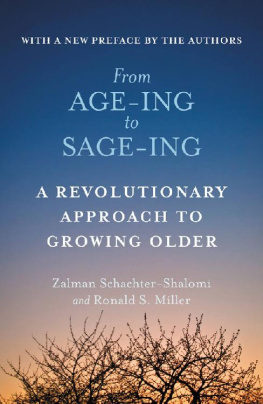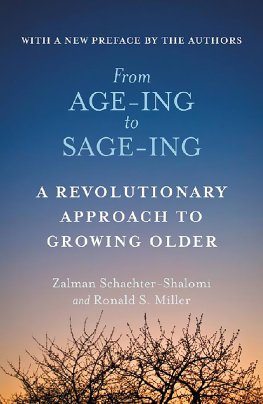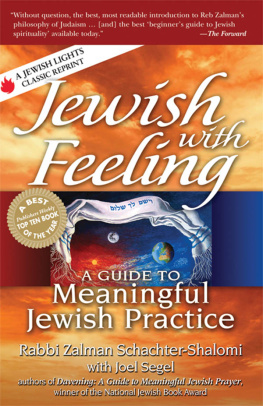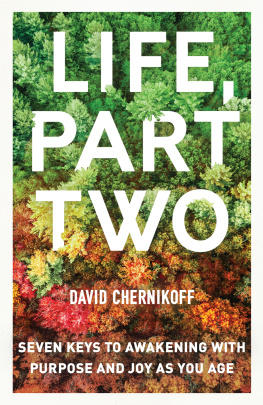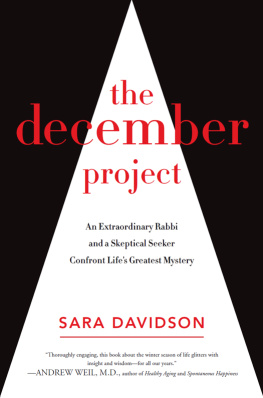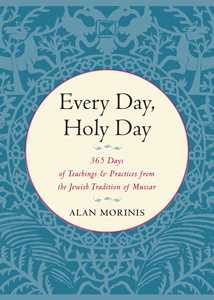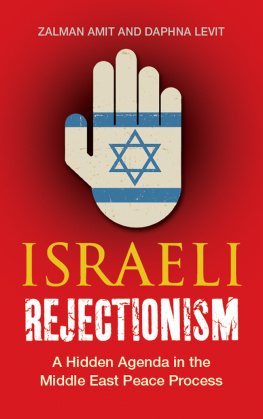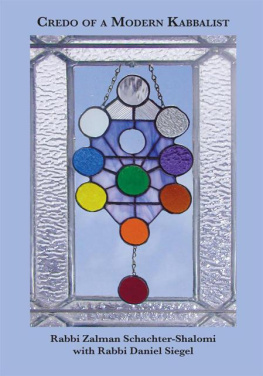Zalman Schachter-Shalomi - From Age-ing to Sage-ing
Here you can read online Zalman Schachter-Shalomi - From Age-ing to Sage-ing full text of the book (entire story) in english for free. Download pdf and epub, get meaning, cover and reviews about this ebook. year: 2008, publisher: Grand Central Publishing, genre: Home and family. Description of the work, (preface) as well as reviews are available. Best literature library LitArk.com created for fans of good reading and offers a wide selection of genres:
Romance novel
Science fiction
Adventure
Detective
Science
History
Home and family
Prose
Art
Politics
Computer
Non-fiction
Religion
Business
Children
Humor
Choose a favorite category and find really read worthwhile books. Enjoy immersion in the world of imagination, feel the emotions of the characters or learn something new for yourself, make an fascinating discovery.
- Book:From Age-ing to Sage-ing
- Author:
- Publisher:Grand Central Publishing
- Genre:
- Year:2008
- Rating:5 / 5
- Favourites:Add to favourites
- Your mark:
- 100
- 1
- 2
- 3
- 4
- 5
From Age-ing to Sage-ing: summary, description and annotation
We offer to read an annotation, description, summary or preface (depends on what the author of the book "From Age-ing to Sage-ing" wrote himself). If you haven't found the necessary information about the book — write in the comments, we will try to find it.
From Age-ing to Sage-ing — read online for free the complete book (whole text) full work
Below is the text of the book, divided by pages. System saving the place of the last page read, allows you to conveniently read the book "From Age-ing to Sage-ing" online for free, without having to search again every time where you left off. Put a bookmark, and you can go to the page where you finished reading at any time.
Font size:
Interval:
Bookmark:

In accordance with the U.S. Copyright Act of 1976, the scanning, uploading, and electronic sharing of any part of this book without the permission of the publisher constitute unlawful piracy and theft of the authors intellectual property. If you would like to use material from the book (other than for review purposes), prior written permission must be obtained by contacting the publisher at permissions@hbgusa.com. Thank you for your support of the authors rights.
To my mother, Chayah Gitl Schachter,
and my sister, Ada Tamar Scharfman,
whose transit occurred during the writing of this book.
Zalman Schachter-Shalomi
To the enduring memory of Tricia Strauss, whose love,
wisdom, and courage taught me by example
how to live and die as an elder.
Ronald S. Miller
I would like to express my deepest appreciation and gratitude to:
Ronald S. Miller, whose insights, scholarship, and in-depth interviews with participants of spiritual eldering workshops brought sparks of creative originality to this book. Crafting words with the deft touch of spiritual sensitivity, he mothered the book as I fathered it. We stimulated and potentiated each other, guided by the spirit that wanted to be incarnated in the book.
Eve Ilsen, my wonderful partner, who constantly reminds me that physical health and the aesthetic dimension are integral aspects of spiritual eldering.
Barry and Debby Barkan and the staff of the Live Oak Institute for inspiration, friendship, and permission to use the Elder Creed in our workshops and in this book.
Lynne Iser for her organizational expertise at the Spiritual Eldering Institute.
Dr. Jean Houston for providing guidance and the practical tools that help people of all ages develop extended consciousness.
Gay Gaer Luce, whose pioneering work at the SAGE (Senior Actualization and Growth Exploration) Project provided a solid foundation upon which to build.
Phillip Mandelkorn for transcriptions of conversations we had when the spiritual eldering work was in its incipient stages.
Omega Institute for sponsoring its groundbreaking conscious aging conference in May 1992.
Rabbi Jeff Roth, who as executive director of Pnai Or Religious Fellowship prepared the organizational space to bring this project to fruition.
Susan Saxe, good friend and executive director of Aleph, the Alliance for Jewish Renewal, the umbrella organization that oversees the Spiritual Eldering Institute.
Livia Szekely and the staff of Rancho La Puerta in Tecate, Mexico, for nourishing body and soul during the writing of the book.
Shrimati Ma Jaya for her inspiration, blessing, and her amazing work with AIDS patients.
A brief but by no means exhaustive list of other friends, colleagues, and teachers who influenced me in writing this book include Professor Martin Buber, Rabbi Schlomo Carlebach, Dr. Ken Dychtwald, Gerald Heard, Dr. Joan Halifax, Rabbi Abraham Joshua Heschel, Dr. Sheldon Isenberg, Pir Vilayat Khan, Maggie Kuhn, Murshid Samuel Lewis, Dr. Helen Luke, Dr. David Morgenstern, Dr. Claudio Naranjo, Ram Dass (Dr. Richard Alpert), Swami Satchidananda, Grand Rabbis Joseph Schneerson and Menachim Schneerson, Dr. Howard Thurman, and Dr. Edith Wallace.
Zalman Schachter-Shalomi
I would like to express my heartfelt appreciation to:
Zalman Schachter-Shalomi, a compassionate elder and dear friend whose vision of spiritual eldering inspired me to write from my creative depths. By sharing with me the triumphs and challenges of his own eldering process with unaffected honesty and sincerity, he has served as a model of the wise, vigorous, fully functioning elder that I am in the process of becoming.
Sarah Jane Freymann, our literary agent, who believed in this project from the very beginning and whose unqualified support helped turn a promising idea into a completed book.
Joann Davis, our editor at Warner Books, whose understanding of spiritual eldering and keen literary skills contributed to the books clarity and readability. Special thanks go to Pippa White for her skillful work on the second edition.
Jeremy Tarcher, the literary matchmaker who was instrumental in bringing Zalman and me together as partners.
Gloria Krasno for her encouragement at the beginning of the project.
Dr. Jag Deva Singh, who provided many insights about how to enrich the retirement years by applying the Indian model of human development to Western society.
Carol Segrave, a visionary gerontologist, who helped deepen my understanding of the economic, political, and psychological problems associated with aging in the United States.
Joseph Chilton Pearce for his insights in brain-mind development and human evolution.
The many wonderful participants of Zalmans spiritual eldering workshops who are quoted throughout the book.
Among the faithful friends who have offered support over the years, I would like to thank Shirin Strauss-Miller and Bobby Dean Miller, Tara Diamond, David Olson, John Narciso, Alan Wise, Michael Segal, Tim Johnson, and Grace Aspiras, an esteemed colleague and dear friend. They have graced my life with a generous supply of love and encouragement that went beyond the call of duty.
Ronald S. Miller
Since we first introduced the revolutionary approach to aging called spiritual eldering in 1995, much has changed in our culture. At the time, most people confronted the prospect of aging with fear as they looked forward to a decades-long decline into personal diminishment and impoverishment. To reverse this negative expectation, we presented the model of the sage or elder of the tribe who benefits from extended longevity by developing extended consciousness. Elders practice contemplative disciplines from our spiritual traditions and come to terms with their mortality. They harvest their life experiences, pass on their wisdom to younger people, and safeguard the health of our ailing planet. Out of their late-life explorations in consciousness, elders bestow upon the world the life-giving wisdom it desperately needs and crown their lives with respect and honor.
In the years following the publication of From Age-ing to Sage-ing, the seeds we planted began sprouting in our culture. We launched the Spiritual Eldering Institute and trained more than one hundred people as seminar leaders in the theory and practice of becoming the possible sage. Spiritual teachers such as Ram Dass, Barry and Debbie Barkan of the Live Oak Institute, and the Institute of Noetic Sciences (IONS) did pioneering work as harbingers of the conscious aging movement. Meanwhile, advances in transpersonal psychology and a variety of meditative systems have given people the contemplative tools to age with awareness. In addition, mainstream and alternative health sciences have made great strides in helping people age more comfortably while staving off dementia and Alzheimers.
So what is the state of spiritual eldering in our culture at this moment? Simply put, its better than it used to be, and at the same time it isnt good enough. Much of the discussion in gerontology today still centers on productive aging, which encourages older people to achieve and stay active, the twin pillars that support the edifice of Western culture. We also find an emphasis on diet, exercise, and cosmetic surgery to mitigate the physical effects of aging. However, we find little emphasis on the inner, contemplative approach to aging in which we transcend doing in favor of being, learning to plumb our psyche for the spiritual gems of wisdom that come from mining our depths. In other words, aging people need to cultivate the inwardness from which wisdom grows, but our culture celebrates staying in the saddle and being productive in later life without a corresponding emphasis on being contemplative.
Font size:
Interval:
Bookmark:
Similar books «From Age-ing to Sage-ing»
Look at similar books to From Age-ing to Sage-ing. We have selected literature similar in name and meaning in the hope of providing readers with more options to find new, interesting, not yet read works.
Discussion, reviews of the book From Age-ing to Sage-ing and just readers' own opinions. Leave your comments, write what you think about the work, its meaning or the main characters. Specify what exactly you liked and what you didn't like, and why you think so.

